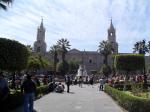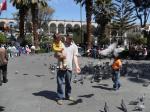We spent a few days in Arequipa last month, you may have already read about part of the adventure here.
Arequipa is the largest city in the south of Peru, known as “la Cuidad Blanca” or the “white city”. It is well known that Arequipa is called “la Cuidad Blanca” because many of the city’s colonial buildings are made out of “sillar”, a white volcanic rock local to the Arequipa area. However, I’ve heard there’s a second reason for the nickname “white city”: when the Spanish settlers arrived in Lima, many found Lima’s climate too cool and humid and moved to Arequipa for its mild and dry climate. As the Spanish settlers with more white-colored skin displaced the native Quechua Indian population, Arequipa became known as “the white city”.
I don’t know if that second story is true but you can’t blame the Spaniards for moving to Arequipa in search for a better climate than Lima. Stuart once said that Arequipa has the most perfect climate on earth and it’s hard to argue with that. Outside of a few rainy months during the Southern hemisphere summer, Arequipa enjoys a mild, dry and sunny climate – all day, every day.
The weather isn’t hot but do bring a hat because the sun is very strong in Arequipa, I guess that must be due to the combination of elevation and dry air. Arequipa, by the way, is at an elevation of 7,550 feet or 2,300 meters, higher than Denver but lower than Cuzco.
There are many reasons to visit Arequipa: it’s far more cosmopolitan and far less touristy than Cuzco. The local food is a bit different (more spicy) than in other parts of Peru. Arequipa has beautiful views, history, culture and a near-perfect climate.
But the most important reason to visit Arequipa is that the city is near to several major volcanos, practically in the shadows of “el Misti Volcano”. One day sooner or later one or all of the volcanos will go KABOOM and then Arequipa as we know it will be history. So go on and get your chupe de camarones and rocoto relleno before it’s too late 🙂
Note: rockheads can download the geology of el Misti Volcano here.
- Arequipa anniversary 2011
- Arequipa Cathedral
- Feeding pigeons at the main square in Arequipa, Peru
- Main square in Arequipa, Peru
- Mirador Yanahuara, Arequipa
- Chupe de Camarones
- Founders Mansion, Arequipa
- A room inside the Founders Mansion, Arequipa
- By the Founders Mansion, Arequipa
- Kola Escoresa, the sweet local soda in Arequipa, Peru
- Misti Volcano, seen from the mirador at Carmen Alto
- Misti Volcano in the background
- la Cuidad Blanca
- la Cuidad Blanca
- Mirador at Carmen Alto, Arequipa














